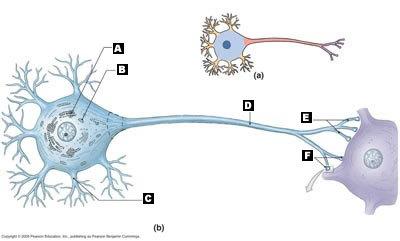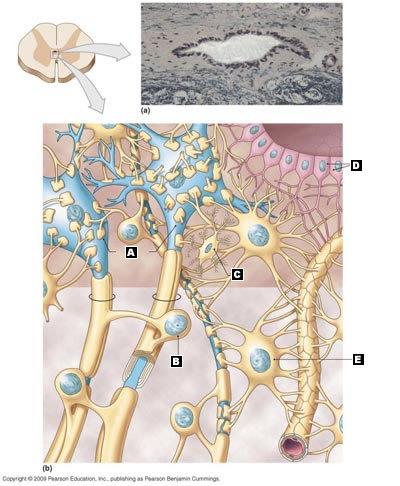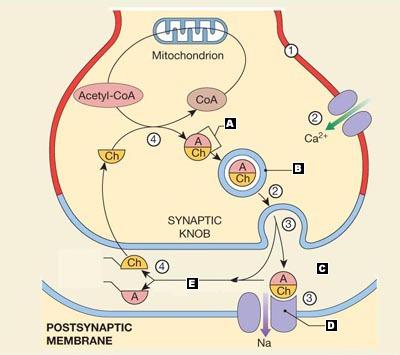Which Of The Following Describes A Change Of Membrane Potential From -70mv To -75mv?
1
The action potential is a transient change in the resting membrane potential from -70 mV to +xxx mV, and so back to -lxx mV. This change is acquired by the opening of first _____ then _____ voltage-gated channels.
2
What area(south) of the neuron generate signals that open the voltage-gated channels in the kickoff role of the axon, thus causing an action potential?
3
As the axon hillock depolarizes, Voltage-gated Na+ channels open and Na+ moves (into or out of) __________ the cell causing further (depolarization or repolarization) __________.
iv
If depolarization reaches -55 mV, an action potential will be generated. What is this -55 mV trigger point called?
5
At the terminate of the depolarization phase, what voltage-gated channels open to help restore the resting membrane potential?
Voltage-gated K+ channels
vi
Repolarization is caused by the move of what ion (sodium or potassium), in what management (into or out of the cell)?
potassium; out of the prison cell
7
After an action potential, the membrane becomes more negative than -seventy mV. This period is called:
eight
Later a neuron has generated an action potential, it cannot generate another 1 for a while. This menstruum is chosen:
the absolute refractory period.
nine
The fastest conduction of an activeness potential would occur in an axon with which of the following characteristics?
Big diameter and myelinated
ten
What is the name of the disease in which the myelin sheaths of central nervous system axons are destroyed?
xi
Which anatomical partition of the nervous arrangement consists of the brain and spinal cord?
12
Which functional division of the nervous system controls skeletal muscle contractions?
13
What part of the neuron is a long cytoplasmic process capable of propagating an activity potential?
14
What part of the neuron consists of the cytoplasm that surrounds the nucleus?
15
Which structural class of neurons consists of neurons with one axon and 1 dendrite?
sixteen
Which functional course of neurons carries electrical signals to control the contraction of polish muscle and cardiac muscle?
17
What type of neuroglial cell participates in the production and circulation of cerebrospinal fluid?
eighteen
What type of neuroglial cell myelinates axons in the peripheral nervous organization?
19
Which type of neuroglial prison cell functions in the primal nervous organization to engulf cellular debris, waste products, and pathogens?
xx
Which type of active channels in the plasma membrane open or close when they demark sure chemicals, such as neurotransmitters?
chemically gated channels
21
A motility of ions that increases the negativity of the resting membrane potential is _____.
22
What is the term for the menses when the voltage-gated sodium channels are opened and the membrane cannot respond to a new stimulus, even a strong one?
absolute refractory catamenia
23
An action potential increases the membrane potential to ___ mV.
24
Which type of axon would propagate action potentials at the highest speed?
big diameter, myelinated
25
What blazon of synapse has the presynaptic and postsynaptic membranes locked together at gap junctions?
Electrical synapses have presynaptic and postsynaptic membranes locked together at gap junctions.
26
What causes the release of acetylcholine (ACh) into the synaptic cleft in a cholinergic synapse?
calcium ions entering the cytoplasm of the synaptic terminal
27
Which neurotransmitter is associated with a person'south emotional states and moods and is linked to low?
28
Which of the post-obit has/have effects similar to morphine and function(due south) to salvage pain?
Dopamine, Endorphin, Serotonin
29
A graded depolarization caused by the inflow of a neurotransmitter at the postsynaptic membrane is a(northward) __________.
excitatory postsynaptic potential (EPSP)
30
The addition of stimuli occurring in rapid succession at a single synapse is chosen __________.
31

Label the following structural components of a neuron.
A. Nissl bodies (RER and complimentary ribosomes)
B. Mitochondrion
C. Dendrite
D. Axon
E. Telodendria
F. Synaptic Terminals
32

Correctly label the cells of the cardinal nervous system on the diagram.
A. Neuron
B. Oligodendrocyte
C. Microglial Cell
D. Ependymal Cell
E. Astrocyte
33

Correctly lucifer the labels to the post-obit parts of a cholinergic synapse.
A. Acetylcholine
B. Synaptic Vesicle
C. Synaptic Cleft
D. ACh Receptor
E. Acetylcholinesterase
34
What is the implication of a mature neuron having no centrioles?
The cell is not able to split up.
35
The axon emerges from the soma at a thickened region chosen the __________.
36
The movement of materials from the soma to the synaptic terminal is called __________.
37
The movement of substances from the synaptic terminal to the soma is chosen __________.
38
Motor neurons class the __________ division of the __________.
39
What type of sensory neurons would Amy, a gymnast, use to inform her encephalon of the position of her skeletal muscles and joints?
40
The ventricles of the encephalon and the key canal of the spinal cord are filled with __________.
41
Which of the following glial cells surrounds jail cell bodies in the PNS and regulates levels of oxygen and carbon dioxide around ganglionic neurons?
42
Which of the following glial cells can grade a myelin sheath around axon fibers in the key nervous system?
43
The transmembrane potential found in all living cells is maintained by __________.
the sodium–potassium pump
44
There are 2 major categories of ion channels: leak channels and __________.
45
Which one of the following statements about the transmembrane potential is correct?
The resting negative accuse on the interior of the plasma membrane is due mainly to charges on proteins.
46
The refractory menstruum occurs __________.
from the time an activeness potential begins until the normal resting potential has stabilized
47
The speed at which an activeness potential is transmitted depends on __________.
the myelination and diameter of the axon
48
Compared with blazon C fibers, blazon A fibers accept a larger diameter and can increase propagation ________ times faster.
49
Presynaptic facilitation __________.
is activity at an axoaxonal synapse that increases the amount of neurotransmitter released when an activeness potential arrives at the synaptic terminal
l
Name some of the functions of the astrocytes.
-Guiding neuron development.
-Repairing damaged nervus tissue.
-Controlling the interstitial environment.
51
A stimulus causes a neuron'due south membrane potential to ascension to −threescore mV. What occurs?
Depolarization, activeness potential, opening of sodium channels
52
Requite some characteristics of saltatory transmission.
-Occurs in myelinated neurons.
-Occurs at the nodes of Ranvier.
-Is faster than continuous propagation.
-1 node of Ranvier to another.
53
During the initiation of an activity potential in an area of excitable membrane, what happens?
A graded potential raises the transmembrane potential toward threshold.
Voltage-regulated sodium ion channels open as threshold is reached.
54
Name the three classes of mechanisms by which neurotransmitters role.
-lipid-soluble gases that tin lengthened into the cell and bind to enzymes inside the prison cell.
-compounds that have an indirect result on membrane potential by means of second messengers.
-compounds that have a direct effect on membrane potential past affecting chemically regulated channels.
55
Extracellular chemicals other than neurotransmitters and neuromodulators can cause ___________________?
facilitation or inhibition of office in neurons.
56
If the axon hillock remains depolarized for an extended time, what will happen?
A new action potential will be generated as presently as the accented refractory menstruation of the previous one has ended.
57
True/Fake. The ependymal cells line the blood vessels that supply the neural tissues of the brain, thereby forming the blood-encephalon barrier.
False. Ependymal cells line the key canal and brain ventricles and may monitor or produce some of the CSF that fills these open spaces.
58
Truthful/False. Neurotransmitters that depress the resting potential are called excitatory.
Imitation. Depressing the resting potential causes hyperpolarization of the membrane and inhibits action potential.
59
True/False. The all-or-none principle applies to excitable membranes, such as neuron membranes. This principle states that either a stimulus is great enough to depolarize a membrane to threshold and thus trigger an action potential, or the stimulus is not able to depolarize to threshold and thus an action potential does not occur.
Truthful. One time the action potential has been triggered, all impulses are identical in forcefulness and speed. Yet, the stimulus must be great plenty to cause the triggering of the action potential.
60
Truthful/False. Unipolar neurons take only one jail cell process, the axon.
Fake. Unipolar neurons have both dendrites and an axon.
61
True/Imitation. Acetylcholine is broken down in the mitochondrion by acetylcholinesterase.
False. Acetylcholine is cleaved downward in the synaptic fissure by acetylcholinesterase.
62
Which part of the nervous organization performs the higher-order thinking required to complete these set of annotation cards?
63
Neurons are responsible for __________.
information transfer and processing in the nervous system
64
The region of a neuron with voltage-gated sodium channels is the __________.
65
Neurons are classified on the ground of their structure as __________.
anaxonic, unipolar, bipolar, multipolar
66
Neurons are classified on the footing of their function equally __________.
motor, sensory, association
67
What are the two major cell populations of neural tissue?
68
Which of the following CNS glial cells removes debris, wastes, and pathogens by phagocytosis?
69
The white matter of the CNS represents a region dominated by the presence of __________.
lxx
Depolarization of the membrane volition shift the membrane potential toward __________.
71
What is the term given to describe a shift in transmembrane potential from −lxx mV to −xc mV?
72
If resting membrane potential is −70 mV and the threshold is −60 mV, a membrane potential of −62 mV will __________.
non produce an action potential
73
At the site of an activeness potential, the membrane contains __________.
an backlog of positive ions inside and an excess of negative ions outside
74
A node along the axon represents an area where __________.
in that location is an absenteeism of myelin
75
Nerve cell bodies in the PNS are clustered together in masses called __________.
76
What are the most important factors that determine the charge per unit of action potential conduction?
the presence or absence of a myelin sheath and the diameter of the axon
77
At an electric synapse, the presynaptic and postsynaptic membranes are locked together at __________.
78
Exocytosis and the release of acetylcholine into the synaptic crack are triggered by __________.
calcium ions flooding into the synaptic concluding
79
An important neurotransmitter in emotional states and moods is __________.
fourscore
An excitatory postsynaptic potential (EPSP) is __________.
a graded depolarization produced by the inflow of a neurotransmitter
81
An inhibitory postsynaptic potential (IPSP) is a __________.
graded hyperpolarization of the postsynaptic membrane
82
Rabies is a viral affliction contracted from the bite of an infected fauna. Rabies bypasses many immune system defenses by traveling in peripheral neurons to reach the CNS. Which method of transport is NOT used past the rabies virus to achieve the CNS?
83
Sensory neurons are responsible for carrying impulses __________.
Efferent pathways consist of axons that carry impulses __________.
84
Interneurons, or clan neurons, differ from sensory and motor neurons in their __________.
exclusive location in the brain and spinal cord
85
Graded potentials that develop on the postsynaptic membrane in response to a neurotransmitter are __________.
86
The addition of stimuli occurring in rapid succession at a single synapse is __________.
87
What type of gated aqueduct opens or closes in response to distortion of the membrane?
mechanically gated channel
88
Interneurons are responsible for __________.
analysis of sensory inputs and coordination of motor outputs
89
Sensory (ascending) pathways distribute information __________.
from peripheral receptors to processing centers in the brain
90
Tyson decides to travel overseas but does not accept all the required vaccines needed earlier he goes. While on his trip, he contracts diphtheria. Which type of glial cell is specially at risk from this disease?
91
Schwann cells are glial cells responsible for __________.
producing a neurilemma around peripheral axons
92
What happens when a barrier prevents the movement of opposite charges toward one another?
A potential departure exists.
93
Which of the following statements about the sodium–potassium pump is correct?
The action of the sodium–potassium pump is needed afterward every activity potential to restore resting potential.
94
Which of the following is a correct statement of the all-or-nada principle?
A given stimulus either triggers a typical action potential or does non produce one at all.
95
During the relative refractory period, a larger-than-normal depolarizing stimulus tin __________.
bring the membrane to threshold and initiate a second action potential
96
Saltatory conduction conducts impulses along an axon __________.
5 to seven times faster than continuous conduction
97
In type C fibers, action potentials are conducted at speeds of approximately __________.
98
The larger the bore of the axon, the __________.
faster the charge per unit of transmission
99
Rachel decides to go swimming, merely when she sticks her large toe into the water, she changes her listen because the water is too cold. The sensory neurons responsible for sending the message most the temperature of the cold h2o are __________.
100
The master functional departure between the autonomic nervous system and the somatic nervous system is that the activities of the ANS are __________.
primarily involuntary, or under "automated" control
101
Lulu, who is l years old, decides she wants to receive Botox treatments. If Botox, short for botulism toxin, prevents the release of ACh from synaptic terminals, what effect should Lulu expect from having Botox injected into her facial muscles?
temporary paralysis in the injected facial muscles
102
What happens when depolarization to threshold occurs?
Voltage-gated sodium channels are opened.
103
Emma is very excited because after taking upwards running several months ago, she has begun to experience the phenomenon called "runner's high." This is caused by the production of endorphins. What is the effect of the endorphins on Emma when she runs?
Endorphins are blocking the transmission of substance P, a neurotransmitter that sends data about pain to the CNS.
104
Which of the following is the most excitatory neurotransmitter in the brain and functions in learning and memory?
105
Ann and Elise are two college students on an overseas holiday. Because they both honey seafood, they end at a eating place in a coastal town for dejeuner. Afterwards dining on shellfish, they become very ill and take trouble breathing. What may accept happened to Ann and Elise?
-They may have consumed some tetrodotoxin (TTX), which tin crusade abnormal sensations.
-They may take consumed saxitoxin (STX), which blocks sodium ion channels.
-They may have consumed ciguatoxin (CTX), which tin interfere with muscle control.
-Whatever of the responses could be correct. TTX, STX, and CTX all block sodium ion channels, cause abnormal sensations, and interfere with muscle control.
106
Facilitation in the neuron'due south transmembrane potential toward threshold results from __________.
-whatever shift that makes the cell more sensitive to further stimulation
-summation of EPSPs
-exposure to sure drugs, such as nicotine.
107
The reason that active neurons need ATP is to support_______.
-the synthesis, release, and recycling of neurotransmitter molecules.
-the recovery from action potentials.
-the movement of materials to and from the soma via axoplasmic flow.
108
The primary functions of the nervous arrangement include ______.
-providing awareness of the internal and external environments
-integrating sensory information
-regulating and controlling peripheral structures and systems
109
Name some construction parts of the PNS.
-a ganglion
-an interneuron within an autonomic ganglion
-a sensory receptor
110
The CNS has _ types of neuroglia. Proper name them.
iv types, ependymal cells, astrocytes, oligodendrocytes and microglia.
111
Ependymal Cells. Where are they located, name their functions.
CNS. They line ventricles (brain) and central culvert (spinal cord); assist in producing, circulating, and monitoring CSF.
112
Astrocytes. Where are they located, name their functions.
CNS. Maintain blood-encephalon bulwark; provide structural support; regulate ion, nutrient, and dissolved gas concentrations; absorb and recycle neurotransmitters; form scar tissue later on injury.
113
Oligodendrocytes. Where are they located, proper name their functions.
CNS. Myelinate CNS axons; provide structural framework.
114
Microglia. Where are they located, name their functions.
CNS. Remove jail cell debris, wastes, and pathogens by phagocytosis.
115
The PNS has _ types of neuroglia. Proper name them and their functions.
2 types. Satallite cells- surround neuron prison cell bodies in ganglia; regulate O2, CO2, nutrient, and neurotransmitter levels around neurons in ganglia.
Schwann Cells- Surround all axons in PNS; responsible for myelination of peripheral axons; participate in repair process after injury.
116
Describe Wallerian degeneration.
The axon distal to the injury site degenerates, and macrophages migrate into the area to clean upward the debris.
117
The sequence of events at a typical cholinergic synapse
Step 1: An arriving ap depolarizes the synaptic concluding.
Stride 2: Calcium ions enter the cytoplasm of the synaptic termina. ACh is released through exocytosis of synaptic vesicles. ACh release ceases because calcium ions are removed from the cytoplasm of the synaptic terminal.
Step 3: ACh diffuses across the synaptic cleft and binds to receptoros of the postsyn. mem. Chemically gated Na+ channels on the postsyn mem open, producing a graded depolarization.
Step 4: The depolarization ends as ACh is broken downwardly into acetate and choline by Ache. The synaptic terminal reabsorbs choline from the synaptic scissure and uses it to resynthesize ACh.
Source: https://www.easynotecards.com/notecard_set/26432
Posted by: carignangatellicited99.blogspot.com


0 Response to "Which Of The Following Describes A Change Of Membrane Potential From -70mv To -75mv?"
Post a Comment